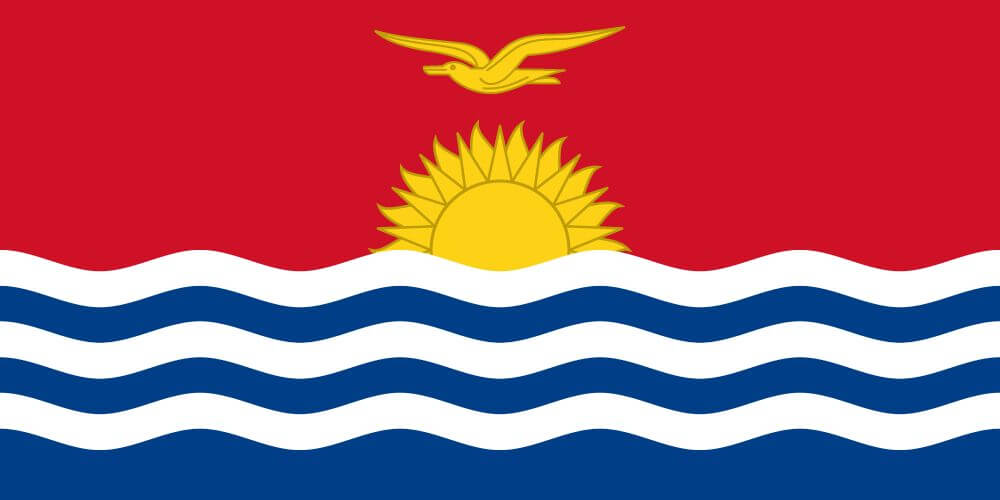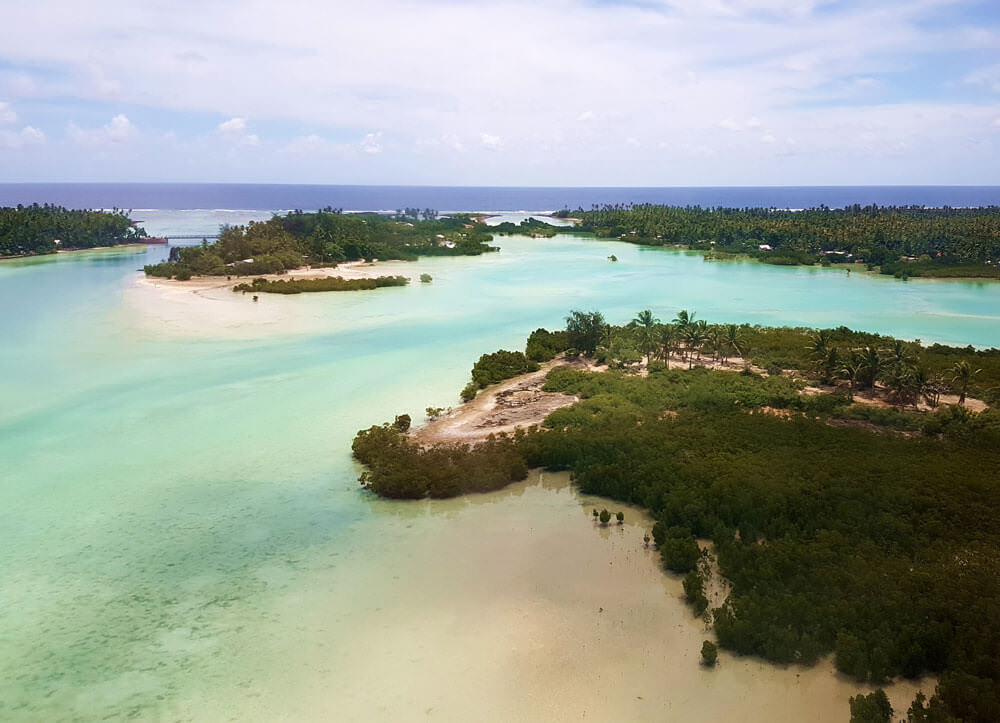Kiribati

Capital city: Tarawa
Population: 121,392 (2021)
Land area: 811 km²
Official languages: English; Gilbertese
Legal system: English common law supplemented by customary law
Time zone: UTC+12, +13, +14
Currency: Australia dollar (AUD)
GDP: 0.22 USD Billion (2021 est.)
Main industries: Fishing, handicrafts
Principal exports: Coconut oil and fish
Located in Oceania in the central Pacific Ocean, the republic of Kiribati is an island nation comprising 32 coral atolls and one elevated limestone island all of which contain three major island groups; the Gilbert group in the west, the Line group in the east and the Phoenix group in the centre. Collectively, the islands have a total land area of 811 sqkm and its exclusive economic zone extends to approximately 3.5 million sqkm. 20 of the 33 islands are inhabited with the Tarawa atoll in the Gilbert Islands known as the capital and the islet of Bairiki of Tarawa considered the country’s administrative centre although the South Tarawa islets of Ambo and Betio are also considered important government centres.
The country straddles the equator about midway from Hawaii to Australia. The largest of Kiribati’s atolls is the Kiritimati Atoll in the Line group which makes up roughly half of the total surface area. The atoll has several large coconut plantations and fisheries and is also used as a satellite telemetry station. The Banaba atoll is a coral and phosphate formation that rises 285 feet above sea level and is known as the highest peak of Kiribati as the other atolls rise to a maximum height of 26 feet, which makes them particularly vulnerable to rising sea levels. For majority of the islet formations, coconut palms are common consequently being the major contributor to the nation’s economy alongside the cultivation of breadfruit, pandanus and cyrtosperma chamissonis.
Demographic
Although the nation covers many small islands, most of Kiribati’s 114,189 population live on the Gilbert Islands, with a smaller proportion on the Line Islands. 95.8% of the civilians are I-Kiribati, 3.8% are I-Kiribati/mixed, 0.2% are Tuvaluan and the remaining 1.7% belong to several different ethnicities. Kiribati has a youthful population with half the population below the age of 25. 57.8% of the population resides in urban areas.
Most of the population speaks I-Kiribati (Gilbertese) or English, both of which are the country’s official languages; the former is more commonly spoken than the latter. The predominant religion is Christianity; 58.9% are Roman Catholic, 21.2% belong to the Kiribati Uniting Church, 8.4% belong to the Kiribati Protestant Church, 5.6% belong to the Church of Jesus Christ of Latter-day Saints, 2.1% are Seventh Day Adventist, 2.1% are Baha’I and 1.7% remain unspecified.
History
It is said that the first inhabitants of the Gilbert Islands and Banaba made their way there from Southeast Asia by way of Micronesia somewhere between 4,000 to 5,000 years ago. The first Europeans to discover the territory were the Spaniards who traversed the Oceanic waters in the 16th century though it was not until at least 3 centuries later till foreign whalers and coconut oil traders began visiting frequently. By the mid-19th century, the local population of the Gilbert Islands were largely recruited to work on plantations across the region.
The Gilbert Islands were the first to become a British protectorate in 1892 followed by the annexation of Banaba in 1900 once it was discovered that the latter had rich deposits of rock phosphate. By 1916 the two protectorates were combined and paired with the Ellice Islands (present-day Tuvalu) to create the Gilbert and Ellice Islands Colony. The Colony also encompassed the Phoenix and Line island groups and, temporarily, Tokelau. Administration of the numerous islands proved difficult due to logistical problems and lack of consistency in governance; these issues were further compounded by the sectarian rivalries between Roman Catholics and Protestants. The Colony remained under British administration until the Japanese occupation during World War II. When the British regained control of the Colony, efforts towards self-governance led to the creation of an elected House of Representatives in 1967. However, resentment and ethnic tensions between the inhabitants of the Gilbert and Ellice Islands resulted in their split in 1975 and subsequently 4 years later on 12 July 1979 the Gilbert Islands achieved independence, renaming their newly created nation Kiribati.
Economic development was prioritised and picked up rapidly following independence, largely due to the abundance of natural resources and the islands’ geographically strategic position astraddle the Equator due to which both Japan and China invested significantly into setting up satellite telemetry stations in the 1990s.

Key dates
1975 The colony is divided into two separate territories, the Gilbert Islands and the Ellice Islands.
1977 The Gilbert Islands obtain internal self-government.
1979 The Gilbert Islands become an independent republic within the Commonwealth under the name of Kiribati on the 12th of July. Ieremia Tabai becomes president.
1982 First elections since independence.
1989 Overcrowding prompts resettlement of inhabitants to other low-lying atolls.
1991 First president, Ieremia Tabai, stands down having served three terms.
2006 Kiribati creates the world’s third-largest marine reserve by March. Fishing is banned in the Phoenix Islands Protected Area, home to hundreds of rare species of fish and coral.
2012 Kiribati cabinet approves plan to buy 6,000 acres of land on Fiji for use if rising sea levels necessitate relocation of Kiribati citizens.
2014 Kiribati makes final payment in May on the purchase of 6,000 acres of land in Fiji for possible relocation.
2014 Fijian Prime Minister Voreqe Bainimarama welcomes Kiribatians to relocate to Fiji if their country is swamped by rising sea levels.
Legal System and Government
Kiribati is a republic with a parliamentary democracy structure. The president is elected by the people from three to four candidates that are selected by the unicameral House of Assembly. The president can serve a maximum of three terms consisting of four years each. The House of Assembly has 42 members of which 40 are elected; 1 seat is reserved for the expatriate Banaba community on Rabi Island in Fiji; and the attorney general, who serves as an ex officio member. The president chooses up to 10 cabinet ministers from the legislature. Local government is through elected island councils.
Kiribati’s legal system has a High Court, which acts as a supreme court, and respects English common law and traditional customary law. It hosts a chief justice and additional judges and can hear appeals from the Court of Appeal and inferior courts. Civil and criminal matters can be addressed by Island courts, whilst native land courts hear property disputes.
Economy
Kiribati is classified as a lower-middle-income country above the regional average in terms of economic freedom, though still below the global average. Due to its geographically isolated location, transport and shipping of goods’ prices are expensive and impractical due to which the exports’ contributions to GDP is below 10 per cent; this explains why the services sector is the backbone of the economy, contributing 67.9 per cent of GDP and employing 74.2 per cent of the labour force. Within the services sector, tourism is particularly important as it generates approximately 20 per cent of the GDP and employs 17 per cent of the nation’s workforce. The fishing industry of Kiribati is significant, not only does it contribute 9 per cent to GDP for Kiribati, the nation is amongst the top fishing grounds for tuna due to which the services pertaining to the issuing of fishing licenses for its exclusive economic zones (EEZs) provides 40 per cent of GDP.
Within the industry sector, which contributes 9 per cent of GDP and recruits 8.9 per cent of the labour force, manufacturing is the predominant source of revenue, largely due to the processing of fish, traditional craft items and small consumer goods mainly for local use. The agriculture sector, which incorporates forestry and fishing, is another notable pillar of the economy as it provides 26 per cent of the GDP revenues. Kiribati is known for the cultivation of copra as well as breadfruit, taro, sweet potatoes, bananas, papaya, and screw pine; the sector engages a large portion of the labour force mainly via employment is subsistence farming, which proves difficult in the infertile and alkaline soil. Challenges notwithstanding, the use of the traditional “te bwabwai pits” which are filled with compost to encourage growth.
Trade
Kiribati’s GDP in 2021 was US$220 million. For the year, the main exports were animal/vegetable fats, oils and waxes (49.6%) and fish, crustaceans, molluscs and other aquatic invertebrates (29.9%) with notable shipments of oilseeds, oleaginous fruits and miscellaneous grains (17.7%). These exports were largely exchanged with New Caledonia (27.5%), Malaysia (19.1%), Japan (19.1%) and Fiji (13.0%). In terms of imports for the year 2021, Kiribati’s main import commodities included mineral fuels, oils and by-products of their distillation (12.5%), oilseeds, oleaginous fruits and miscellaneous grains (6.7%), electrical machinery and appliances (6.4%) and vehicles other than tramway/railway rolling stock (5.7%). These products were majorly procured from Fiji (16.3%), China (15.8%), Australia (14.5%) and Singapore (14.5%).
Kiribati is a signatory of the Pacific Island Countries Trade Agreements (PICTA) which is considered a part of the more extensive Pacific Agreement on Closer Economic Relations (PACER). The island nation also benefits from the “Everything But Arms” agreement with the European Union (EU).

Investment Opportunities
Kiribati is a politically and social stable country, predominantly peaceful with crime and corruption rates below the global average. While ease of doing business, transparency in governance, banking and quality of regulations are below world averages, the government has included their improvement in the Kiribati 20-Year Vision development plan that was officially launched in 2016. The Pacific island nation’s trade openness, fiscal balance, volume of remittances and rate of economic globalisation are noticeably above the average, highlighting the nation’s potential to cultivate a thriving economic ecosystem and potential hub for foreign investment. As the nation gradually recovers from the effects of the COVID-19 pandemic, economic growth is expected to bounce back gradually. Additionally, the government of Kiribati has made environmental sustainability and reversal of the effects of climate change a pertinent priority, rightfully so considering the nation is amongst the most vulnerable to climate change, with rising sea levels and imminent danger to the civilians residing by the coastlines.
Projects looking into sustainable fisheries, eco-tourism and green finance are a lucrative area of investment. Considering the nation’s desire to increase the contribution of its exports, vocational training for skilled labour, information and communications technology, manufacturing and processing of raw materials and shipping are all areas Kiribati requires investments to grow the economy and generate jobs so as to solve the challenge of the nation’s 30 per cent unemployment rate. Additionally, several infrastructural development projects were delayed due to the disruptions caused by the global pandemic since 2019, due to which projects remain in the pipeline and may be highly profitable for foreign investors; these projects include both land-based and marine infrastructure projects.
Due to the nation’s location near the equator, investment in space launching and satellite telemetry prove to be profitable. The island of Banaba, which was previously used for mining phosphate, does not house many people, and could be better used for space exploration and research projects. Such projects would create employment and bring capital to the country’s economy.
Due to Kiribati’s abundance of fishing waters, demand for suitable fishing equipment and storage facilities for exported marine produce could be met through foreign investment.
Due to rising sea levels, landfill sites are scarce in Kiribati. The lack of adequate waste disposal infrastructure has left some onshore lagoons polluted. Projects which aim to utilise uninhabited atolls in Kiribati could solve this problem and could potentially serve as a stable investment.